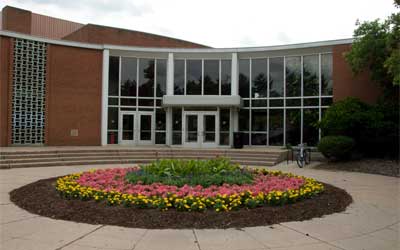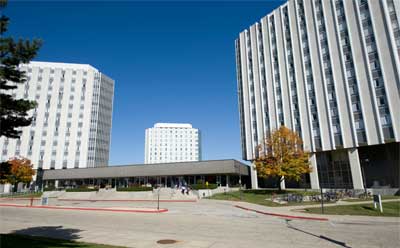After years of deterioration and a dubious two-decade reign atop NIU’s capital budget request list, the Stevens Building is drawing nearer to its long-awaited transformation.
Construction will begin after Jan. 1, 2014, following an environmental survey planned for early in the fall and the letting of bids in October.
First, though, the two departments that call the building home must clear out.
Faculty and staff from the Department of Anthropology and the School of Theatre and Dance begin moving Monday, May 20, mostly to the vacant “A” tower of Grant.
“Everybody’s thrilled that this is going to happen. The trucks are showing up Monday,” said Alex Gelman, director of the School of Theatre and Dance. “Stevens is going to be fabulous – a tremendous building. We have terrific architects and campus people working with us.”
“We see the move as a temporary adjustment … a short-term pain for long-term gain. We’re looking forward to the new space,” added Kendall Thu, chair of the Department of Anthropology.
“We’ve endured the Stevens Building for years; I’ve been in there 14 years, many of my colleagues longer. I can’t tell you the number of times we’ve had water problems, climate-control problems, students-complaining-about-the-space problems.”
Pat Bell, planning associate in the Capital Budget, Architecture, Planning and Safety unit of the NIU Division of Finance and Facilities, said faculty and staff from Theatre and Dance will primarily occupy the third floor of Grant “A” while the Department of Anthropology will move to the fifth floor.
Graduate students from both areas will share the fourth floor, he said.
Visitors to the new digs will need to wait until the first week of June while crews haul everything from furniture and books to costumes and set up the new offices and other spaces, added David Booth, marketing director for Theatre and Dance.
When the fall semester begins, Bell said, the northeast door of Grant A will serve as the entrance.
August also will begin at least two years of theater and dance classes scattered across campus.
The school’s “Mainstage Series” productions, normally performed in the O’Connell Theatre or Players Theatre, will move to Huntley Middle School, 1515 S. Fourth St. in DeKalb. The “Studio Series,” normally performed in the Corner Theatre, will stay on campus in the Diversions Lounge of the Holmes Student Center.
Space is being rented on Route 38 for the scenery shop, Booth said.
While the long construction period will present inconveniences for the school, Gelman said that everyone is willing to sacrifice for what awaits them when the Stevens Building project is completed.
“The actual classrooms will be better than what we’ve had. They’ll be heated and air-conditioned, and it won’t rain inside,” Gelman said. “The construction period will be challenging, though, because we won’t be in the same building. The community of being in the same building means a lot.”
Much of the Department of Anthropology’s collection, which includes 20,000 bones, was moved during spring break to a storage space in Cole Hall. Everything else, include lab equipment, computers, standard office fixtures and “artifacts that archeologists have,” will move to Grant.
Although Thu and his colleagues worry about the temporary headquarters on the far west end of campus and the impact of that on students, they also are eager for when the blueprints become reality.
The cutting-edge teach labs “really continue the university’s focus on engaged learning. That’s what the building’s going to be set up for,” Thu said.
“We’re very much looking forward to the new building. They worked very closely with us on the design, and they’ve done a fantastic job in designing it,” he added. “We feel an ownership over the new building already.”
Gov. Pat Quinn released $10.3 million for the Stevens Building and Cole Hall projects in January of 2010; Cole Hall reopened last fall.
Rehabilitation plans for Stevens include a new, 6,000-square-foot lecture auditorium with tiered seating for up to 330 students, state-of-the-art teaching technology and the flexibility to be divided into three smaller rooms.
Other additions including adding about 10,500 square feet to the Black Box Theatre, which will feature a 30-foot ceiling, and 13,300 square feet to the scene shop. Workers also will put on a new roof, replace the heating, ventilation and air conditioning systems and modernize the plumbing and electrical wiring.
The Stevens Building opened in 1959.




